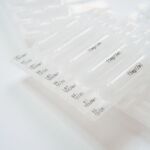The market database suggests that filtration is defined as the process of separating solids from liquids or gases through mechanical, physical, or biological operations. The filtration process uses the filter medium to separate solid from liquid, the fluid passes through the solid particle. The desired product might be the solid particle, which is removed from the fluid or the clarified liquid itself. The market analysis states that the basic requirement of a lab filtration system includes the filter medium, the fluid that contains solids that are suspended, a mechanical device, which holds the filter medium and allows a force application, and a force that drives the fluid through the system that may include a pressure difference. Filtration lab chemistry filters include membrane filters, Syringe filters, vacuum filtration systems, and bottle top filter systems.
Filter paper
According to business intelligence tools, filter paper for laboratory use is considered a semi-permeable paper membrane that is used to separate solid particles from liquids or gases. It has good filtration and absorption properties, which are helpful in the process of separation. Filter papers for laboratory most of them are made up of cotton fibers, which in turn are made of cellulose. Filter papers are made in different ways for different uses. There are different types of filter papers available, the following are a few types. Qualitative filter paper, quantitative filter papers, Glass fiber filters, Quartz fiber filters, Cellulose extraction thimbles, MCE Membranes, Microfiltration membranes, and Syringe filters.
The Right selection of filter paper
The filter paper is available in so many different varieties, that it is necessary that the right one must be selected. Laboratory filter papers used for quantitative and qualitative analysis are different. The Right selection of filter paper is needed to get correct results from your filtration process.
Selecting qualitative filter paper
To determine, separate, and identify the material, the key factors considered to determine the right kind of qualitative filter paper include Chemical Compatibility, Pore Size, Wet Strength, Filtration Method, and Filtration Efficiency. According to the market database, Chemical Compatibility is noted to be the measure of the stability of the substance when mixed with other substances. The qualitative filter should not mix with the solvent to be filtered. Additionally, Business intelligence tools state that the pore size is the size of the filtration paper pores, which allows the filtrate to pass through. Higher is the filter capacity when the pore is denser. Based on the pores there are 13 different grades of filter paper, which are used for qualitative analysis.
As per the definition derived through market analysis, wet strength is a measure of when it’s wet and how well the qualitative paper can hold. For the filtration of strong acidic acid or alkaline solutions, wet-strengthened qualitative paper can be used.
Business intelligence tools state that the filtration methods used extensively across a range of filters include basic, cellulose, paper, and gravity filtration filters. Glass microfiber filters are used where ignition is required. Lastly, by filtering paper, the right size and the right amount of particles can be stopped or retained. The higher the filtration efficiency when the fiber diameter is smaller than the qualitative filter paper medium.
Selecting the right quantitative filter paper
According to the market database, quantitative filter papers are used to determine the quantity of the substance included in the test specimen. It is available in three different forms, Hardened Ashless, Ashless, and hardened low ash. The factors used to determine and establish the right kind of filter paper include Size, Binder content, Wet Strength, and Filtering Techniques employed.
As mentioned, market analysis suggests that the filtering paper’s effective area will be larger if it has a larger size. Due to this, it can be used for a long time because it offers less resistance In terms of Binder content in the filter paper it is noted that the efficiency of the filtration process is affected by this parameter. Filtration of coarse and voluminous precipitates is done by the open fiber structure of the filter paper. On the other hand, to capture fine-grained precipitates a tight fiber matrix in the filter paper will be good.
As per the market database, it is noted that in order to withstand pressure and vacuum filtration, the quantitative filter paper should have high wet strength. Lastly, filtration methods are noted to be a key qualitative factor that helps determine the application and selection of a said filter paper.
The filter needed for wastewater filtration varies from system to system. This is necessary for a number of reasons. The type of lab filtration system is affected by the water coming into the system. The second thing, which plays in the type of filter, is the purity of the water needed to be reused after being filtered. The wastewater treatment system uses two types of filtration processes they are membrane filtration and particle filtration.


